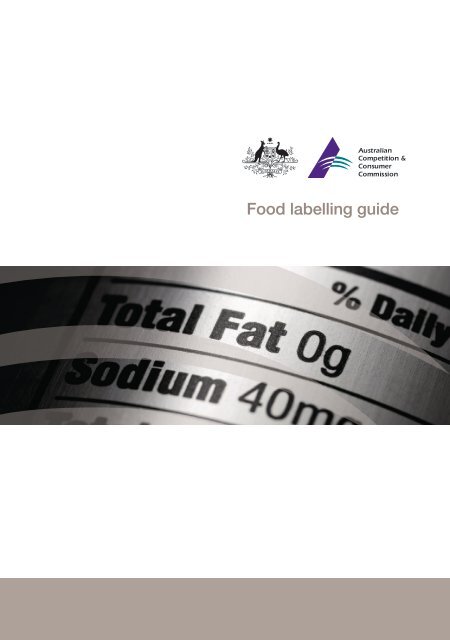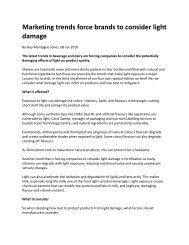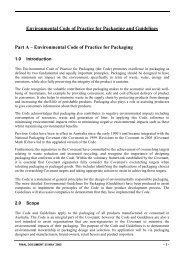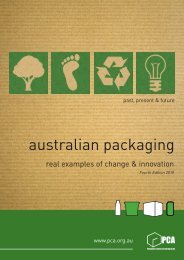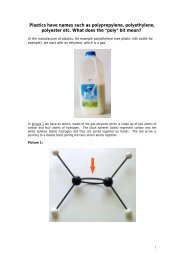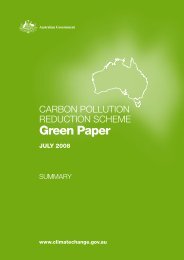Food labelling guide - the Packaging Council of Australia
Food labelling guide - the Packaging Council of Australia
Food labelling guide - the Packaging Council of Australia
Create successful ePaper yourself
Turn your PDF publications into a flip-book with our unique Google optimized e-Paper software.
<strong>Food</strong> <strong>labelling</strong> <strong>guide</strong>
<strong>Australia</strong>n Competition and Consumer Commission<br />
23 Marcus Clarke Street, Canberra,<br />
<strong>Australia</strong>n Capital Territory, 2601<br />
First published by <strong>the</strong> ACCC 2009<br />
10 9 8 7 6 5 4 3 2 1<br />
© Commonwealth <strong>of</strong> <strong>Australia</strong> 2009<br />
This work is copyright. Apart from any use permitted<br />
by <strong>the</strong> Copyright Act 1968, no part may be<br />
reproduced without prior written permission from<br />
<strong>the</strong> Commonwealth available through <strong>the</strong> <strong>Australia</strong>n<br />
Competition and Consumer Commission. Requests<br />
and inquiries concerning reproduction and rights<br />
should be addressed to <strong>the</strong> Director Publishing,<br />
<strong>Australia</strong>n Competition and Consumer Commission,<br />
GPO Box 3131, Canberra ACT 2601 or by email to<br />
publishing.unit@accc.gov.au.<br />
ISBN 978 1 921581 25 0<br />
ACCC 06/2009_37775<br />
www.accc.gov.au
<strong>Food</strong> <strong>labelling</strong> <strong>guide</strong>
Contents<br />
Introduction 1<br />
<strong>Australia</strong>’s food and beverage industry 1<br />
1. Responsibilities <strong>of</strong> <strong>the</strong> ACCC and FSANZ 3<br />
<strong>Australia</strong>n Competition and Consumer Commission 3<br />
<strong>Food</strong> Standards <strong>Australia</strong> New Zealand 4<br />
2. <strong>Australia</strong> New Zealand <strong>Food</strong> Standards Code 5<br />
Percentage <strong>labelling</strong> 5<br />
Distinguishing ingredients from components 5<br />
3. The Trade Practices Act 7<br />
How <strong>the</strong> code and <strong>the</strong> Act work toge<strong>the</strong>r 7<br />
Words, images and <strong>the</strong> overall impression 8<br />
Target audience 11<br />
What about qualifying claims, fine print and disclaimers 12<br />
Penalties and remedies for breaching <strong>the</strong> Act 13<br />
Avoiding a breach <strong>of</strong> <strong>the</strong> law 14<br />
Important note 15<br />
Checklist—how to avoid breaching <strong>the</strong> Trade Practices Act 16<br />
Contacts 17
Introduction<br />
<strong>Australia</strong>’s food and beverage industry<br />
As <strong>Australia</strong>’s largest manufacturing sector, <strong>the</strong> food and beverage industry significantly affects<br />
<strong>the</strong> lives <strong>of</strong> <strong>Australia</strong>n consumers. It is vital that industry participants understand <strong>the</strong>ir legal<br />
obligations to consumers when <strong>labelling</strong>, packaging and promoting <strong>the</strong>ir products.<br />
This <strong>guide</strong>line<br />
The main purpose <strong>of</strong> this <strong>guide</strong>line is to educate businesses in <strong>the</strong> food and beverage industry<br />
about <strong>the</strong>ir obligation to ensure that <strong>the</strong>ir product <strong>labelling</strong>, packaging and advertising is<br />
accurate and is not likely to mislead consumers.<br />
In particular, <strong>the</strong> <strong>Food</strong> <strong>labelling</strong> <strong>guide</strong> highlights <strong>the</strong> obligation <strong>of</strong> businesses to avoid making<br />
any claims or representations on a food or beverage label, package or advertisement that<br />
indicates that an ingredient is a predominant ingredient in that product 1 , if that is not<br />
<strong>the</strong> case.<br />
This <strong>guide</strong>line also explains and distinguishes <strong>the</strong> roles <strong>of</strong> two key agencies that regulate<br />
<strong>the</strong> food and beverage industry—<strong>Food</strong> Standards <strong>Australia</strong> New Zealand (FSANZ) and <strong>the</strong><br />
<strong>Australia</strong>n Competition and Consumer Commission (ACCC).<br />
This <strong>guide</strong> seeks to assist you to apply <strong>the</strong> law in your everyday business practices, by<br />
providing you with practical examples <strong>of</strong> <strong>the</strong> types <strong>of</strong> claims and representations you can and<br />
cannot make about your products when developing food and beverage <strong>labelling</strong>, packaging<br />
and advertising.<br />
1 For <strong>the</strong> purposes <strong>of</strong> this <strong>guide</strong>, reference to a predominant ingredient should be read as a predominate ingredient <strong>of</strong> that<br />
type, unless o<strong>the</strong>rwise specified.<br />
1 <strong>Food</strong> <strong>labelling</strong> <strong>guide</strong>
This <strong>guide</strong> is divided into three main parts:<br />
1.<br />
2.<br />
3.<br />
Responsibilities <strong>of</strong> <strong>the</strong> ACCC and FSANZ<br />
<strong>Australia</strong> New Zealand <strong>Food</strong> Standards Code<br />
Trade Practices Act<br />
A checklist on how to avoid breaching <strong>the</strong> Trade Practices Act is included at <strong>the</strong> end <strong>of</strong> <strong>the</strong><br />
publication.<br />
2 <strong>Food</strong> <strong>labelling</strong> <strong>guide</strong>
1.<br />
Responsibilities <strong>of</strong> <strong>the</strong> ACCC and FSANZ<br />
<strong>Australia</strong>n Competition and Consumer Commission<br />
The ACCC has produced this <strong>guide</strong> with <strong>the</strong> assistance <strong>of</strong> FSANZ. The ACCC is an<br />
independent national statutory law enforcement agency responsible for bringing about<br />
compliance with <strong>the</strong> Trade Practices Act 1974 by encouraging vigorous competition in <strong>the</strong><br />
marketplace and promoting <strong>the</strong> Act’s consumer protection laws.<br />
Part <strong>of</strong> <strong>the</strong> ACCC’s compliance role is to ensure that businesses do not make representations<br />
about food and beverage products that are false or likely to mislead or deceive consumers.<br />
The ACCC has become increasingly concerned about representations on <strong>the</strong> labels,<br />
packaging and advertisements <strong>of</strong> food and beverage products that imply, without appropriate<br />
qualification, that a particular ingredient is predominant when this is not <strong>the</strong> case.<br />
The ACCC has formed a view, supported by a number <strong>of</strong> recent Federal Court <strong>of</strong> <strong>Australia</strong><br />
decisions, that this practice is likely to mislead consumers and breach <strong>the</strong> Trade Practices Act.<br />
The ACCC will <strong>the</strong>refore continue to respond when <strong>the</strong>se concerns are raised, and, where<br />
appropriate, take legal action for any conduct that breaches <strong>the</strong> Act.<br />
O<strong>the</strong>r ACCC publications about representations in <strong>the</strong> food and beverage industry can be<br />
downloaded from <strong>the</strong> Publications page on <strong>the</strong> ACCC website.<br />
3 <strong>Food</strong> <strong>labelling</strong> <strong>guide</strong>
<strong>Food</strong> Standards <strong>Australia</strong> New Zealand<br />
Like <strong>the</strong> ACCC, FSANZ is an independent statutory authority. It develops and reviews food<br />
standards under <strong>the</strong> <strong>Australia</strong> New Zealand <strong>Food</strong> Standards Code for foods sold in or<br />
imported into <strong>Australia</strong> and New Zealand.<br />
The <strong>Food</strong> Standards <strong>Australia</strong> New Zealand Act 1991 provides that FSANZ’s objectives in<br />
developing or reviewing food regulatory measures are (in descending priority) <strong>the</strong>:<br />
• protection <strong>of</strong> public health and safety<br />
• provision <strong>of</strong> adequate information about food to enable consumers to make informed<br />
choices<br />
• prevention <strong>of</strong> misleading or deceptive conduct.<br />
Under its Act, FSANZ’s objectives are to achieve a high degree <strong>of</strong> consumer confidence in <strong>the</strong><br />
quality and safety <strong>of</strong> food and to provide adequate information about food within <strong>the</strong> context<br />
<strong>of</strong> <strong>the</strong> agency’s objectives. However, in contrast to <strong>the</strong> ACCC’s role in regulating a broad<br />
range <strong>of</strong> industries, FSANZ specifically focuses on developing and varying food standards by<br />
working in partnership with <strong>the</strong> governments <strong>of</strong> <strong>Australia</strong> and New Zealand.<br />
FSANZ does not enforce <strong>the</strong> <strong>Australia</strong> New Zealand <strong>Food</strong> Standards Code, but aims to:<br />
• protect public health and safety <strong>of</strong> <strong>the</strong> people <strong>of</strong> <strong>Australia</strong> and New Zealand<br />
• provide <strong>Australia</strong>n and New Zealand consumers with adequate information about food<br />
products to help <strong>the</strong>m make informed choices<br />
• prevent misleading or deceptive conduct in <strong>the</strong> <strong>Australia</strong>n and New Zealand food and<br />
beverage industries.<br />
4 <strong>Food</strong> <strong>labelling</strong> <strong>guide</strong>
2.<br />
<strong>Australia</strong> New Zealand <strong>Food</strong><br />
Standards Code<br />
FSANZ is mainly responsible for developing and administering <strong>the</strong> <strong>Australia</strong> New Zealand <strong>Food</strong><br />
Standards Code, a collection <strong>of</strong> individual food standards that include standards for food<br />
composition and <strong>labelling</strong>.<br />
Standard 1.2.10—Characterising ingredients and components <strong>of</strong> food sets out <strong>the</strong> specific<br />
requirements for <strong>the</strong> declaration <strong>of</strong> <strong>the</strong> percentage <strong>of</strong> <strong>the</strong> characterising ingredients and<br />
components <strong>of</strong> certain food products that must be declared.<br />
Percentage <strong>labelling</strong><br />
The code requires that when characterising food ingredients, food manufacturers should use<br />
percentage <strong>labelling</strong> on <strong>the</strong>ir products, unless an exemption applies.<br />
Percentage <strong>labelling</strong> requires that <strong>the</strong> proportion <strong>of</strong> <strong>the</strong> characterising components and/or<br />
ingredients <strong>of</strong> that food or beverage should be declared on <strong>the</strong> label. This information may<br />
be presented in a variety <strong>of</strong> ways, including within <strong>the</strong> ingredients list, in conjunction with <strong>the</strong><br />
product name or in <strong>the</strong> nutrition information panel.<br />
Distinguishing ingredients from components<br />
Under <strong>the</strong> code:<br />
• an ingredient is used in <strong>the</strong> preparation <strong>of</strong> food, manufacture or handling <strong>of</strong> food<br />
a • component is a natural part <strong>of</strong> an ingredient in a food and so is not usually added to a<br />
food on its own (e.g. caffeine is naturally present in c<strong>of</strong>fee and <strong>the</strong>refore is a component).<br />
5 <strong>Food</strong> <strong>labelling</strong> <strong>guide</strong>
A component or ingredient is considered to be characterising and <strong>the</strong>refore must be declared<br />
on <strong>the</strong> food label as a proportion when <strong>the</strong> component or ingredient is:<br />
• mentioned in <strong>the</strong> name <strong>of</strong> a food (e.g. strawberry may be <strong>the</strong> characterising ingredient in<br />
strawberry yoghurt)<br />
• customarily associated with <strong>the</strong> name <strong>of</strong> <strong>the</strong> food by <strong>the</strong> consumer (e.g. fish may be <strong>the</strong><br />
characterising ingredient in fisherman’s pie)<br />
• emphasised on <strong>the</strong> label <strong>of</strong> a food in words, pictures or graphics (e.g. fruit juice may be<br />
<strong>the</strong> characterising ingredient in real fruit juice sweets).<br />
The code’s requirement that characterising ingredients and components be declared on food<br />
labels enables consumers to identify how much <strong>of</strong> a characterising ingredient or component is<br />
present in <strong>the</strong> product. In turn, this assists consumers to compare one product with ano<strong>the</strong>r<br />
and to make informed choices about <strong>the</strong> foods <strong>the</strong>y purchase.<br />
All food standards within <strong>the</strong> code are enforceable under <strong>the</strong> food Acts in each state and<br />
territory <strong>of</strong> <strong>Australia</strong>, and in New Zealand. It is an <strong>of</strong>fence in both countries to supply food<br />
that does not comply with relevant food standards. Agencies responsible for enforcing and<br />
interpreting <strong>the</strong> code within <strong>Australia</strong> are state and territory health departments and, where <strong>the</strong><br />
code relates to imports, <strong>the</strong> <strong>Australia</strong>n Quarantine and Inspection Service. In New Zealand, <strong>the</strong><br />
New Zealand Government is responsible for this role. Because food standards are given legal<br />
effect by state, territory and New Zealand laws, it is important that <strong>the</strong> code’s requirements<br />
are considered in conjunction with <strong>the</strong> relevant local food legislation, including <strong>the</strong> Trade<br />
Practices Act.<br />
6 <strong>Food</strong> <strong>labelling</strong> <strong>guide</strong>
3.<br />
The Trade Practices Act<br />
The Trade Practices Act has two provisions dealing with representations in food and beverage<br />
<strong>labelling</strong>, packaging or advertising:<br />
1. Businesses must not engage in misleading or deceptive conduct, or conduct likely to<br />
mislead or deceive consumers. For example, businesses must not make representations<br />
likely to mislead or deceive consumers about <strong>the</strong> most prominent ingredients or<br />
characteristics <strong>of</strong> a food or beverage product. It does not matter whe<strong>the</strong>r <strong>the</strong> conduct<br />
has actually mislead a consumer or whe<strong>the</strong>r <strong>the</strong> business intended to mislead—if <strong>the</strong><br />
conduct is likely to mislead or deceive, <strong>the</strong> Act is contravened.<br />
2. Businesses must not falsely represent that a food or beverage is <strong>of</strong> a particular standard,<br />
quality, value, grade, composition or style in relation to <strong>the</strong> supply, or possible supply, <strong>of</strong><br />
a food or beverage. In short, this means that a food and beverage product must comply<br />
with any description or claim made on <strong>the</strong> <strong>labelling</strong>, packaging or promotional material,<br />
including any representation implying that a particular ingredient is a prominent ingredient<br />
in that product.<br />
How <strong>the</strong> code and <strong>the</strong> Act work toge<strong>the</strong>r<br />
While <strong>the</strong> <strong>Australia</strong> New Zealand <strong>Food</strong> Standards Code and <strong>the</strong> Act seek to address broadly<br />
similar conduct within <strong>the</strong> food and beverage industry, <strong>the</strong>ir focus and approach in addressing<br />
<strong>the</strong>se issues vary in a number <strong>of</strong> important ways.<br />
Most importantly, referring to a particular ingredient in <strong>the</strong> name or packaging <strong>of</strong> a food when<br />
it is not a prominent ingredient <strong>of</strong> that product may breach <strong>the</strong> Act. This is <strong>the</strong> case even if<br />
<strong>the</strong> code may not require <strong>the</strong> ingredient to be listed on <strong>the</strong> food’s label because it was simply<br />
‘used in small quantities for <strong>the</strong> purposes <strong>of</strong> flavouring’ (an exemption to characterising<br />
ingredient under Standard 1.2.10).<br />
Put simply, even when a business ensures a product complies with <strong>the</strong> code by providing<br />
<strong>the</strong> correct information on <strong>the</strong> food label, <strong>the</strong> Act requires fur<strong>the</strong>r steps be taken to ensure<br />
7 <strong>Food</strong> <strong>labelling</strong> <strong>guide</strong>
that <strong>the</strong> business does not make any representations on <strong>the</strong> product’s <strong>labelling</strong>, packaging or<br />
advertising likely to mislead a consumer into believing that a particular ingredient is prominent<br />
when it is not.<br />
Words, images and <strong>the</strong> overall impression<br />
When a business makes a representation about a food product, it must ensure <strong>the</strong> overall<br />
impression <strong>of</strong> <strong>the</strong> representation is not misleading or deceptive. Many factors influence<br />
whe<strong>the</strong>r an ingredient is predominant in <strong>the</strong> class <strong>of</strong> ingredients present and whe<strong>the</strong>r<br />
statements about <strong>the</strong> ingredient may be misleading. These factors rely on <strong>the</strong> overall<br />
impression conveyed through <strong>the</strong> words, images and general ‘get up’ <strong>of</strong> a product’s <strong>labelling</strong>,<br />
packaging and promotional material. An audience may be misled by emphasis on different<br />
aspects <strong>of</strong> <strong>the</strong> representation or by mistaken—but understandable (and uncorrected)—<br />
assumptions and preconceptions.<br />
For example, if a business uses an image <strong>of</strong> a rare and delicious ingredient on its new product<br />
label, minor ingredients should not be given a disproportionately large pictorial emphasis<br />
because this is likely to mislead consumers.<br />
The ACCC assesses each matter on a case-by-case basis. For example, particular care<br />
needs to be paid to <strong>the</strong> <strong>labelling</strong> <strong>of</strong> new products that consumers may be unfamiliar with,<br />
while traditional associations and familiarity with a product may lead consumers to make<br />
assumptions or apply preconceptions because <strong>of</strong> <strong>the</strong> overall impression given by <strong>the</strong> <strong>labelling</strong>.<br />
examples<br />
In April 2008 <strong>the</strong> Federal Court declared (by consent) that <strong>the</strong> packaging <strong>of</strong> a number<br />
<strong>of</strong> Arnott’s Biscuits Ltd’s Snack Right products, including Snack Right Apple and<br />
Blackberry Fruit Pillow and Snack Right Apricot Fruit Slice falsely conveyed a particular<br />
overall impression. The court declared <strong>the</strong> packaging falsely conveyed an overall<br />
impression that <strong>the</strong> filling in <strong>the</strong> biscuits consisted predominantly <strong>of</strong> <strong>the</strong> fruits referred<br />
to in <strong>the</strong> product name and on its packaging when in fact <strong>the</strong> filling mainly consisted <strong>of</strong><br />
o<strong>the</strong>r fruits. For example, <strong>the</strong> Apple and Blackberry Fruit Pillow filling only comprised<br />
around 1.7 per cent blackberry concentrate, along with almost 40 per cent sultanas,<br />
12.9 per cent apple concentrate and 8.6 per cent dried apple concentrate. In <strong>the</strong><br />
Apricot Fruit Slice filling only 1.7 per cent was apricot, while 64.8 per cent was sultana.<br />
8 <strong>Food</strong> <strong>labelling</strong> <strong>guide</strong>
Arnott’s provided an undertaking to <strong>the</strong> court that it would amend <strong>the</strong> products’<br />
packaging, refrain from similar conduct in <strong>the</strong> future and publish a corrective notice<br />
on its website. It also agreed to review its trade practices compliance program and<br />
contribute to <strong>the</strong> ACCC’s legal costs.<br />
ACCC v Arnott’s Biscuits Ltd (2008)—re. Arnott’s Snack Right Biscuits<br />
In a similar case, <strong>the</strong> Federal Court declared that Nudie <strong>Food</strong>s <strong>Australia</strong> Pty Ltd had<br />
made misleading claims about two <strong>of</strong> its juice products, Rosie Ruby and Rosie Blue.<br />
The claims were not only made on product labels but in advertising campaigns in<br />
Sydney, Melbourne and Brisbane, including on signboards on buses and trams, street<br />
posters and postcard flyers.<br />
Nudie represented Rosie Ruby juice was solely Cranberry Cloudy juice when in fact is<br />
comprised 80 per cent reconstituted apple juice. Rosie Blue was promoted as solely<br />
Cranberry Blueberry juice when it was actually 78 per cent reconstituted apple juice.<br />
The court declared (by consent) that Nudie had breached ss. 52, 53(a) and 55<br />
<strong>of</strong> <strong>the</strong> Act. Nudie was ordered to publish corrective advertisements, establish<br />
an education, training and trade practices compliance program and to pay <strong>the</strong><br />
ACCC’s costs.<br />
ACCC v Nudie <strong>Food</strong>s <strong>Australia</strong> Pty Ltd (2008)—re. Rosie Ruby and Rosie Blue juices<br />
In 2004 <strong>the</strong> Federal Court found that Cadbury Schweppes Pty Ltd had engaged<br />
in conduct likely to mislead or deceive consumers by representing that two Cottee’s<br />
cordial products contained extracts <strong>of</strong> real fruit depicted pictorially on its packaging.<br />
The <strong>labelling</strong> on <strong>the</strong> banana mango–flavoured cordial used <strong>the</strong> words ‘banana mango’<br />
in large print, pictures <strong>of</strong> bananas and mangoes and a ‘Go Bananas’ motif, when <strong>the</strong><br />
product did not contain any real banana or mango. The <strong>labelling</strong> on <strong>the</strong> apple kiwi–<br />
flavoured cordial concentrate used <strong>the</strong> words ‘apple kiwi’ in <strong>the</strong> name <strong>of</strong> <strong>the</strong> product<br />
and pictures <strong>of</strong> cut kiwi fruit when <strong>the</strong>re were no kiwi fruit in <strong>the</strong> product.<br />
The court declared that some reasonable consumers would be misled or deceived by<br />
<strong>the</strong> representations, leading <strong>the</strong>m to believe that <strong>the</strong> products contained <strong>the</strong> real fruits<br />
represented.<br />
This case demonstrates <strong>the</strong> importance <strong>of</strong> <strong>the</strong> consumers’ overall impression when<br />
conveying <strong>the</strong> contents <strong>of</strong> products.<br />
9 <strong>Food</strong> <strong>labelling</strong> <strong>guide</strong>
In 2009 <strong>the</strong> ACCC acted against Coca-Cola South Pacific Pty Ltd (CCSP) regarding<br />
its ‘myth-busting’ advertising campaign featuring promotional material that <strong>the</strong> ACCC<br />
considered could mislead consumers about <strong>the</strong> nutritional qualities <strong>of</strong> Coca-Cola.<br />
The advertisements sought to correct apparent ‘myths’ associated with Coca-Cola and<br />
appeared by <strong>the</strong>ir design to be educative messages or articles.<br />
One advertisement referred to a number <strong>of</strong> ‘myths’ about Coca-Cola, including that<br />
it ‘makes you fat’, ‘rots your teeth’ and is ‘full <strong>of</strong> added preservatives and artificial<br />
flavours’. Ano<strong>the</strong>r advertisement addressed to all Coca-Cola customers said,<br />
‘… we felt it was time to state <strong>the</strong> facts and to help you understand <strong>the</strong> truth behind<br />
Coca-Cola’.<br />
In claiming that <strong>the</strong> advertisements were misleading or deceptive, <strong>the</strong> ACCC asserted<br />
that Coca-Cola is high in calories and simple carbohydrates, which can contribute to<br />
weight gain, and that it contains high amounts <strong>of</strong> sugar and acid, which can contribute<br />
to <strong>the</strong> erosion <strong>of</strong> tooth enamel.<br />
CCSP provided <strong>the</strong> ACCC with court enforceable undertakings to refrain from making<br />
statements in <strong>the</strong> future that could not be substantiated, to implement a trade practices<br />
law compliance review and to publish corrective notices in newspapers and on its<br />
website, where it would also publish <strong>the</strong> correct levels <strong>of</strong> caffeine for Coca-Cola drink<br />
products.<br />
10 <strong>Food</strong> <strong>labelling</strong> <strong>guide</strong>
Target audience<br />
When designing product labels, packaging and o<strong>the</strong>r promotional material, it is important that<br />
businesses carefully consider how consumers may interpret any representations made.<br />
To avoid misleading consumers, you should consider <strong>the</strong> potential target audience for <strong>the</strong><br />
product and how that audience may interpret <strong>the</strong> product’s packaging, <strong>labelling</strong> or promotional<br />
material. Even if you believe <strong>the</strong> product representations are clear and well structured,<br />
customers may still be misled by <strong>the</strong>m. Consumers who purchase your product may not fit<br />
<strong>the</strong> pr<strong>of</strong>ile <strong>of</strong> <strong>the</strong> intended target audience and may interpret <strong>the</strong> product representations<br />
differently. You need to keep in mind that consumers are not expected to have <strong>the</strong> same level<br />
<strong>of</strong> understanding about product representation as food scientists and chefs.<br />
To reduce <strong>the</strong> possibility <strong>of</strong> misunderstanding, your product labels and packaging should be<br />
designed on <strong>the</strong> basis that some consumers may make <strong>the</strong>ir purchasing decisions on <strong>the</strong><br />
basis <strong>of</strong> <strong>the</strong> product’s <strong>labelling</strong> and packaging ra<strong>the</strong>r than by consulting <strong>the</strong> ingredients list on<br />
<strong>the</strong> back or side <strong>of</strong> <strong>the</strong> package.<br />
A representation need not be intentionally false to breach <strong>the</strong> Trade Practices Act—a breach<br />
can occur where a misrepresentation is careless or unintended. Whe<strong>the</strong>r you intend <strong>the</strong><br />
<strong>labelling</strong>, packaging or promotional material to be misleading to a consumer is irrelevant to<br />
establishing a breach. However, false representations are considered more serious breaches<br />
than misleading conduct, and <strong>the</strong>refore carry higher penalties.<br />
The Act effectively says that businesses must not make erroneous representations about <strong>the</strong>ir<br />
products or services. Accordingly, businesses need to implement risk management processes<br />
to ensure that <strong>the</strong>ir product representations are accurate and not likely to mislead consumers.<br />
exampLE<br />
The ACCC was concerned that <strong>the</strong> overall impression created by <strong>the</strong> packaging <strong>of</strong><br />
Natur-all Pty Ltd’s (trading as Go Natural) fruit pieces in yoghurt implied <strong>the</strong> products<br />
were unprocessed berry and/or apricot pieces coated in yoghurt. In fact, <strong>the</strong> product<br />
was made from a fruit-based mixture consisting <strong>of</strong> 35 per cent fruit concentrate,<br />
30 per cent sugar and 30 per cent semolina.<br />
Go Natural provided a court enforceable undertaking to <strong>the</strong> ACCC, agreeing to amend<br />
<strong>the</strong> products’ packaging, amend representations about <strong>the</strong> product that appeared on<br />
its website, publish an article for <strong>the</strong> food industry about its experience, and review and<br />
amend its trade practices law compliance program.<br />
Natur-all Pty Ltd (2008)—re. Go Natural berry pieces in yogurt<br />
11 <strong>Food</strong> <strong>labelling</strong> <strong>guide</strong>
What about qualifying claims, fine print and disclaimers<br />
When making representations about <strong>the</strong> prominence <strong>of</strong> particular ingredients in food or<br />
beverage products, businesses should provide sufficient and appropriate information to<br />
enable consumers to make a reasonable and informed judgment about whe<strong>the</strong>r to purchase<br />
<strong>the</strong> product. Businesses may, for example, need to include additional information on a label<br />
to qualify <strong>the</strong> emphasis given to a particular ingredient, if this emphasis is potentially false,<br />
misleading or deceptive.<br />
Fine-print qualifications and disclaimers (e.g. <strong>the</strong> use <strong>of</strong> an asterisk or ‘Conditions apply’<br />
statement leading to a fine-print disclaimer) are <strong>of</strong>ten used in food and beverage <strong>labelling</strong>.<br />
Businesses may sometimes try using <strong>the</strong>m to promote a selling point, while putting <strong>the</strong><br />
conditions in fine print in an attempt to avoid any misrepresentation.<br />
However, this may not be enough to avoid breaching <strong>the</strong> Trade Practices Act. The main selling<br />
point used for a product may create such a strong impression on a consumer that it cannot be<br />
qualified or corrected by a disclaimer or qualification found elsewhere on <strong>the</strong> label, packaging<br />
or advertisement. If an advertisement conveys an overall impression likely to be misleading<br />
and deceptive, it will breach <strong>the</strong> Act even though aspects or parts <strong>of</strong> <strong>the</strong> advertisement can be<br />
found that are inconsistent with that impression.<br />
A disclaimer cannot be used to correct a misrepresentation. In effect, <strong>the</strong> Act says that<br />
businesses must not make erroneous representations about <strong>the</strong>ir products or services.<br />
Businesses cannot <strong>the</strong>refore make any type <strong>of</strong> potentially misleading representation and<br />
expect to qualify that with a disclaimer or in <strong>the</strong> fine print. Ultimately a representation will be<br />
judged on <strong>the</strong> overall impression that is created.<br />
Where a qualification is not prominent or clear enough, <strong>the</strong> advertisement can still be<br />
misleading, depending on its overall impression on its audience. The advertisement must<br />
clearly direct attention to <strong>the</strong> most significant terms and conditions, so that consumers can<br />
readily have <strong>the</strong> information <strong>the</strong>y need to make informed purchasing decisions.<br />
12 <strong>Food</strong> <strong>labelling</strong> <strong>guide</strong>
exampLE<br />
Austrimi Seafoods Pty Ltd manufactured a crumbed seafood product called<br />
‘Kalamari’. The product’s packaging featured a picture <strong>of</strong> crumbed seafood rings and<br />
<strong>the</strong> ACCC was concerned that this, combined with <strong>the</strong> name Kalamari, created <strong>the</strong><br />
impression <strong>the</strong> rings were made predominantly <strong>of</strong> squid or calamari. The ingredients list<br />
showed that squid was only 4 per cent <strong>of</strong> product.<br />
Austrimi provided <strong>the</strong> ACCC with court enforceable undertakings that in future it will not<br />
supply <strong>the</strong> product in <strong>the</strong> packaging <strong>of</strong> concern, use <strong>the</strong> name Kalamari on <strong>the</strong> product<br />
or supply seafood products in packaging and/or <strong>labelling</strong> that conveys an overall<br />
impression that <strong>the</strong> product consists mainly, or includes a not insubstantial portion, <strong>of</strong> a<br />
particular seafood ingredient when this is not <strong>the</strong> case.<br />
The company also agreed to place a corrective notice on its website, implement a<br />
trade practices law compliance program and to work with its retail customers to place<br />
corrective notices at point <strong>of</strong> sale for 28 days.<br />
Austrimi Seafoods Pty Ltd (2008)—re. Kalamari<br />
Penalties and remedies for breaching <strong>the</strong> Act<br />
The ACCC, consumers and competitors can all take legal action if representations made on a<br />
product’s label, packaging or in related advertising potentially breach <strong>the</strong> Trade Practices Act.<br />
The business or person making <strong>the</strong> representation in contravention <strong>of</strong> <strong>the</strong> Act can be sued for<br />
damages.<br />
The penalties and remedies available for breaching <strong>the</strong> unfair practices provisions <strong>of</strong> <strong>the</strong> Act<br />
are extensive and include:<br />
2<br />
• monetary penalties <strong>of</strong> up to $1.1 million for companies and up to $220 000 for individuals<br />
• damages (e.g. payment <strong>of</strong> money to compensate competitors for <strong>the</strong> business <strong>the</strong>y have<br />
lost as a result <strong>of</strong> a misleading promotion)<br />
• injunctions to prevent <strong>the</strong> prohibited conduct continuing, being repeated or to require<br />
some action to be taken<br />
• specific performance (ordering a business or individual to do something specific)<br />
2 Monetary penalties are currently only available for a breach <strong>of</strong> <strong>the</strong> criminal provisions in Part VC <strong>of</strong> <strong>the</strong> Trade Practices Act.<br />
13 <strong>Food</strong> <strong>labelling</strong> <strong>guide</strong>
• o<strong>the</strong>r orders <strong>of</strong> various kinds in favour <strong>of</strong> people who have suffered loss or damage as a<br />
result <strong>of</strong> <strong>the</strong> conduct, such as refunding money to consumers.<br />
The ACCC can also seek a range <strong>of</strong> o<strong>the</strong>r orders from <strong>the</strong> court, including adverse publicity<br />
and corrective advertising orders.<br />
Avoiding a breach <strong>of</strong> <strong>the</strong> law<br />
If a business has a trade practices compliance program in place, it can identify and reduce <strong>the</strong><br />
risk <strong>of</strong> breaching <strong>the</strong> Trade Practices Act and rapidly and effectively remedy any breach that<br />
may occur.<br />
A trade practices compliance program involves training and educating management and staff<br />
about <strong>the</strong>ir obligations under <strong>the</strong> Act, and is aimed at preventing future breaches occurring<br />
because <strong>of</strong> ignorance <strong>of</strong> <strong>the</strong> law. This training will <strong>of</strong>ten be accompanied by <strong>the</strong> establishment<br />
<strong>of</strong> a robust framework—such as stricter approval procedures for <strong>labelling</strong>, packaging and<br />
advertising as well as regular compliance checks throughout <strong>the</strong> business—to ensure future<br />
breaches <strong>of</strong> <strong>the</strong> Act do not occur.<br />
Having someone with legal expertise in trade practices law to approve any promotional<br />
material can also help avoid any misleading claims and reduce <strong>the</strong> possibility <strong>of</strong> any potential<br />
breaches.<br />
14 <strong>Food</strong> <strong>labelling</strong> <strong>guide</strong>
Important note<br />
The ACCC’s views are not a static statement <strong>of</strong> ‘<strong>the</strong> law’, as <strong>the</strong> interpretation <strong>of</strong> <strong>the</strong> Trade<br />
Practices Act ultimately depends on decisions <strong>of</strong> <strong>the</strong> courts and/or changes to <strong>the</strong> legislation<br />
made by parliament. The ACCC’s current views on how <strong>the</strong> Act generally applies to <strong>labelling</strong>,<br />
packaging and advertising in <strong>the</strong> food and beverage industry are primarily based on past<br />
experience and court decisions about <strong>the</strong> relevant laws.<br />
Therefore, this <strong>guide</strong>line should not be used in place <strong>of</strong> legal advice about a business’s<br />
particular circumstances. The ACCC approaches each potential enforcement matter on a<br />
case-by-case basis, taking all relevant circumstances into account. Businesses may also be<br />
subject to action by private parties, including competitors.<br />
The ACCC encourages businesses engaging in food and beverage <strong>labelling</strong>, packaging and<br />
advertising to incorporate <strong>the</strong> principles set out in this <strong>guide</strong>line into <strong>the</strong>ir everyday practices.<br />
Doing so will minimise <strong>the</strong> risks <strong>of</strong> making illegal claims about products and possible ACCC<br />
action.<br />
This <strong>guide</strong>line only applies to goods intended for sale in <strong>Australia</strong>. Any food manufactured in<br />
<strong>Australia</strong> for export should seek to comply with <strong>the</strong> country <strong>of</strong> destination’s laws.<br />
15 <strong>Food</strong> <strong>labelling</strong> <strong>guide</strong>
Checklist—how to avoid breaching <strong>the</strong><br />
Trade Practices Act<br />
As you are looking at whe<strong>the</strong>r your <strong>labelling</strong>, packaging or promotion may mislead consumers,<br />
consider <strong>the</strong> following:<br />
• What will consumers think <strong>the</strong> predominant ingredients <strong>of</strong> <strong>the</strong> product are and does this<br />
impression match <strong>the</strong> true facts<br />
• Do any aspects <strong>of</strong> <strong>the</strong> <strong>labelling</strong> or packaging need stronger emphasis<br />
• How will consumers interpret <strong>the</strong> words and <strong>the</strong> images used<br />
• What is <strong>the</strong> overall impression created by <strong>the</strong>se words and images<br />
• What is <strong>the</strong> likely conclusion consumers will draw from that impression<br />
• What could consumers possibly miss or fail to appreciate<br />
• If you have used a disclaimer or qualification, is it sufficiently prominent and clear to<br />
overcome any misleading impressions<br />
• How will susceptible members <strong>of</strong> <strong>the</strong> target audience react<br />
16 <strong>Food</strong> <strong>labelling</strong> <strong>guide</strong>
Contacts<br />
Infocentre: 1300 302 502<br />
Website: www.accc.gov.au<br />
Callers who are deaf or have a hearing or speech impairment can contact <strong>the</strong> ACCC through<br />
<strong>the</strong> National Relay Service www.relayservice.com.au<br />
For o<strong>the</strong>r business information go to www.business.gov.au<br />
Addresses<br />
National <strong>of</strong>fice<br />
23 Marcus Clarke Street<br />
Canberra ACT 2601<br />
GPO Box 3131<br />
Canberra ACT 2601<br />
Tel: (02) 6243 1111<br />
Fax: (02) 6243 1199<br />
New South Wales<br />
Level 7<br />
Angel Place<br />
123 Pitt Street<br />
Sydney NSW 2000<br />
GPO Box 3648<br />
Sydney NSW 2001<br />
Tel: (02) 9230 9133<br />
Fax: (02) 9223 1092<br />
Victoria<br />
Level 35<br />
The Tower<br />
360 Elizabeth Street<br />
Melbourne Central<br />
Melbourne Vic 3000<br />
GPO Box 520<br />
Melbourne Vic 3001<br />
Tel: (03) 9290 1800<br />
Fax: (03) 9663 3699<br />
Queensland<br />
Brisbane<br />
Level 3<br />
500 Queen Street<br />
Brisbane Qld 4000<br />
PO Box 10048<br />
Adelaide Street Post Office<br />
Brisbane Qld 4000<br />
Tel: (07) 3835 4666<br />
Fax: (07) 3832 0372<br />
Townsville<br />
Level 6<br />
Central Plaza<br />
370 Flinders Mall<br />
Townsville Qld 4810<br />
PO Box 2016<br />
Townsville Qld 4810<br />
Tel: (07) 4729 2666<br />
Fax: (07) 4721 1538<br />
Western <strong>Australia</strong><br />
Third floor<br />
East Point Plaza<br />
233 Adelaide Terrace<br />
Perth WA 6000<br />
PO Box 6381<br />
East Perth WA 6892<br />
Tel: (08) 9325 0600<br />
Fax: (08) 9325 5976<br />
South <strong>Australia</strong><br />
Level 2<br />
19 Grenfell Street<br />
Adelaide SA 5000<br />
GPO Box 922<br />
Adelaide SA 5001<br />
Tel: (08) 8213 3444<br />
Fax: (08) 8410 4155<br />
Nor<strong>the</strong>rn Territory<br />
Level 8<br />
National Mutual Centre<br />
9–11 Cavenagh St<br />
Darwin NT 0800<br />
GPO Box 3056<br />
Darwin NT 0801<br />
Tel: (08) 8946 9666 (general)<br />
Tel: (08) 8946 9610 (reception)<br />
Fax: (08) 8946 9600<br />
Tasmania<br />
Third floor, AMP Building<br />
86 Collins Street<br />
(Cnr Elizabeth and Collins streets)<br />
Hobart Tas 7000<br />
GPO Box 1210<br />
Hobart Tas 7001<br />
Tel: (03) 6215 9333<br />
Fax: (03) 6234 7796<br />
17 <strong>Food</strong> <strong>labelling</strong> <strong>guide</strong>
www.accc.gov.au<br />
18 <strong>Food</strong> <strong>labelling</strong> <strong>guide</strong>


